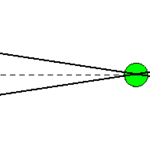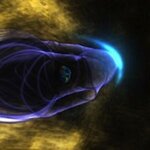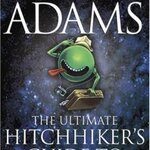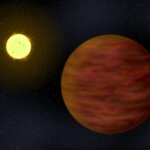Space

Michael Richmond of Rochester Institute of Technology created a simple example for how to determine the astronomical unit - the distance from Earth to the Sun and therefore the basis for all modern measurements in space for the CLEA workshop in 2004, the last time we had a transit of Venus - and it won't happen again in our lifetimes so tomorrow is the last chance to see it.
Since links don't generate a lot of traffic and he was kind enough to post this under a Creative Commons license, we are printing it here to (hopefully) get it the audience it deserves. You can also find…
For the second and last time this century, the planet Venus will pass over the visible disk of our Sun for observers located in the Americas (in the evening of June 5th) and western Europe (in the morning of June 6th). The event has a noteworthy scientific value -particularly for exoplanetary searches-, but it is also quite spectacular to observe, if you have some modest equipment (but you should be able to spot it with your naked eye, provided you only look through a thick-smoked glass; never look at the Sun directly!). The added value is that probably none of us will be around the next time…

The word 'lunacy' is derived from the longheld belief that people act a little crazier during a full moon. We know the moon - Luna - effects us, its gravitational pull creates ocean tides and many ancient cultures thought it could also affect our health or state of mind.
While there is no link between the moon and human lunacy, spacecraft and computer simulations reveal that the moon does indeed have the cosmic kind; a far-reaching, invisible influence on the solar wind.
The solar wind is a thin stream of electrically conducting gas called plasma that's constantly blown off the surface…

Recently I was taking pictures of the night sky. My intention was to photograph the double star Epsilon Lyrae. It’s actually a double-double, made of two closer pairs, as one can see through a telescope of three-or-more inches aperture. However, the pairs themselves are quite far apart, and can be easily resolved with the unaided eye.
However, my camera flipped from manual focus (on infinity) to autofocus (on whatever), as it tends to do if not touched for a minute. To my surprise, the effect was most pleasing.
I was first of all struck by how red the star Delta-2…

June 5, 2012 you get to share a communal experience with scientists from hundreds of years ago. No, I don't mean Calculus, I mean one of the rarest and more interesting recurring events science has been able to witness since the invention of the telescope - a transit of Venus.
You may not have heard of it but you know of it if you ever wondered how astronomers were able to calculate how far away the Sun is from Earth - the basis of the Astronomical Unit (AU) that is eponymous today.
If you are literate enough to read this article, you know that there are two planets between us and the…

For Douglas’s sake, don’t forget your towel on Friday! 5/25/12 is not just the annual Towel Day to honor the genius of Douglas Adams, but Super Towel Day (5 + 25 + 12 = 42!!!!) A day that won’t recur for another … century, when
the cosmic solution to life, the universe, and everything just may be
revealed.
Why a towel? It is, after all …. “the massively useful thing
an interstellar hitchhiker can have. Partly it has great practical value
– you can wrap it around you for warmth as you bound across the cold
moons of Jaglan Beta; you can lie on it on the brilliant marble sanded…

Giant planets have diverse chemistry; Jupiter, for example, first formed as a large solid core and then then accreted gas from the disk around it, which led to a different chemistry in its outer layers. When the Galileo spacecraft entered Jupiter’s atmosphere in 1995, it found the proportion of heavier elements (astronomers call these ‘metals’) to be three times higher than in the Sun.
Brown dwarfs, around the same size, are instead star-like objects with insufficient mass to ignite hydrogen fusion in their cores. Over time they cool to temperatures of just a few hundred degrees. Like stars…

Type Ia supernovae are important for measuring the universe because they're bright enough to be seen across large distances and similar enough to be a reference, an an object of known luminosity - but astronomers still don't know what star systems make Type Ia supernovae.
Two very different models might explain the possible origin of Type Ia supernovae and different studies support each model. Some new evidence says both models are correct because some supernovae are produced one way and some the other.
Type Ia supernovae are known to originate from carbon-oxygen white dwarfs, the dense…

Stars live for a long time - millions of years - but near the end of their lives, some massive stars go through what astronomers call the yellow supergiant phase.
Because the timeframe is so short, cosmically, witnessing a yellow supergiant phase is rare - almost as rare as a Kardashian staying married when ratings slip. Like with celebrity relationships, if you want to witness the big meltdown you have to stay vigilant in astronomy. And keep your camera running.
Astronomers from Lowell Observatory have successfully acted as 'stellar paparazzi', managing to identify hundreds of these…

Last week it was asteroid mining, as Peter Diamandis and his partners showed us their bold new venture, Planetary Resources,
aiming eventually to start harvesting trillions of dollars worth of
materials that would then no longer have to be ripped out of Mother
Earth.
This glimpse of a vigorously bold and can-do future provoked The Daily Show's Jon Stewart to comment, "Do you know how rarely the news in 2012 looks and sounds how you thought news would look and sound like in 2012?"
to fervent approval from his audience. Having worked in this area 30
years ago, I was thrilled to see…